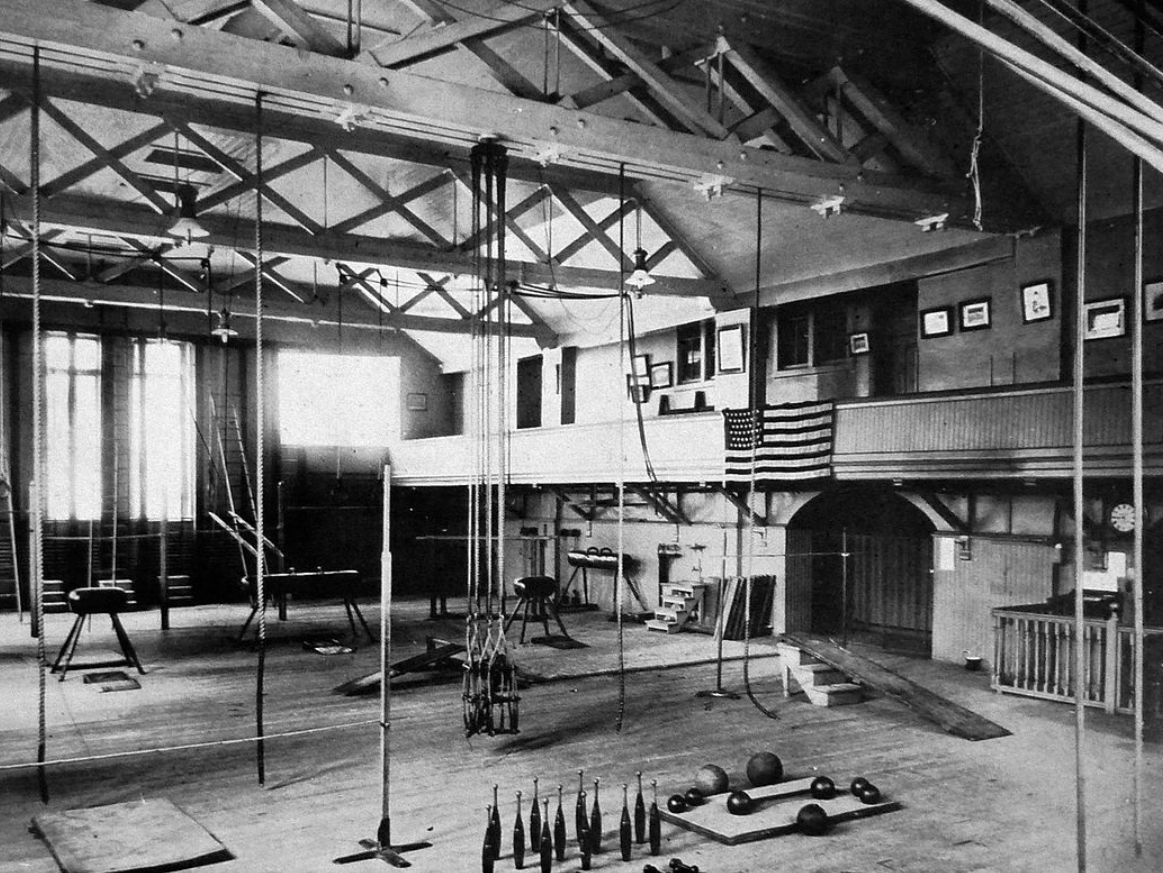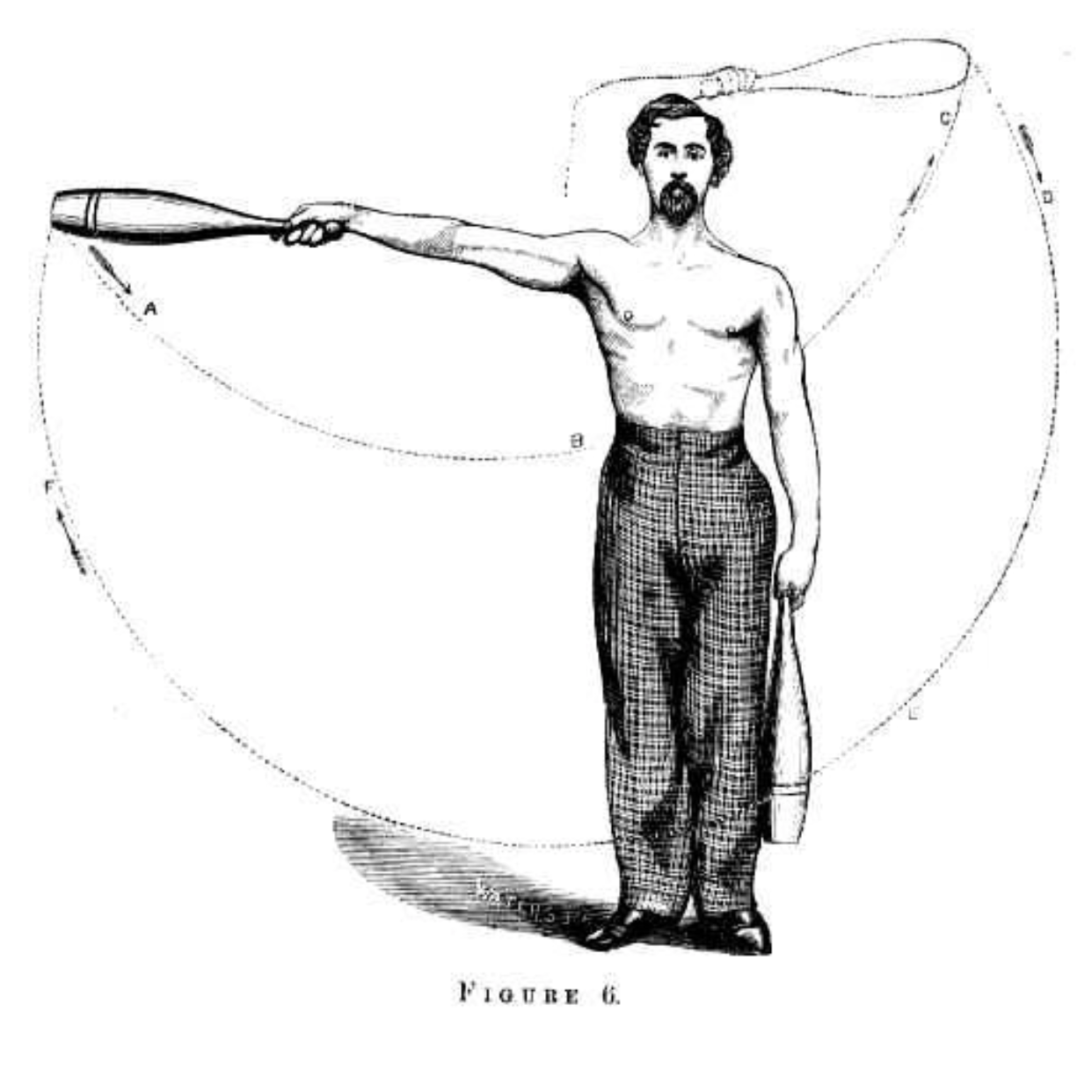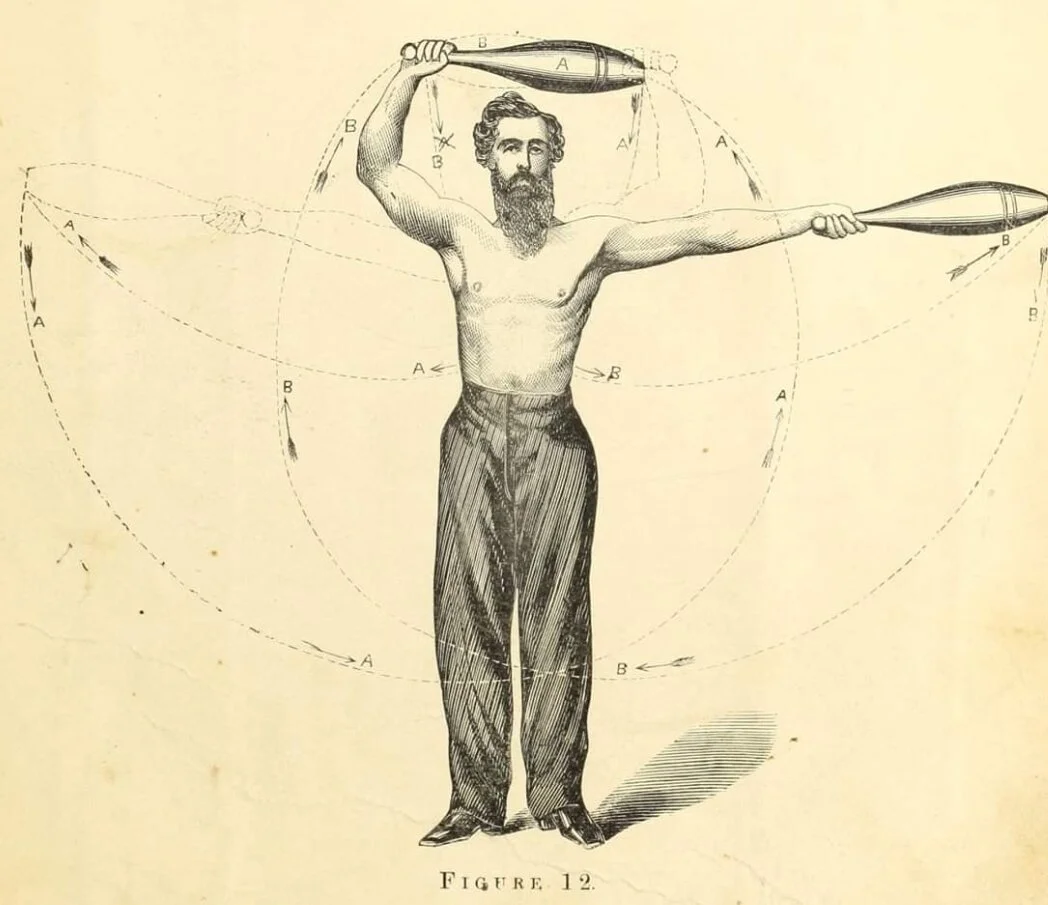How to use Indian Clubs
If there was an exercise tool that represents my Nourishing Moves philosophy it’s Indian clubs! Training with Indian clubs can be thought of as gymnastics for the mind and restoration for the body. The circular patterns trained while using the clubs work in harmony with the body's natural spiral make up. Being light weight (0.5kgs-3kgs) also makes Indian clubs portable and perfect to take outdoors to train with.
This post will briefly describe Indian club history with a video tutorial series at the end to get you started swinging your Indian clubs based on Sim D. Kehoe's traditional British military style.
Like all great things Indian clubs aren’t new and have stood the test of time. Many different cultures throughout history have used clubs as weapons, hunting tools as well as training apparatus to improve overall strength, mental agility and overall health.
The strongest historical record of club swinging for physical culture comes from Iran. The large Meels as they called them were then introduced to India around 1256 AD during the Mongal invasion of Iran.
It was during the 19th century that the British army picked up the art during their occupation of India. Officers started club swinging as a way of training the body, improving strength and skill. Club swinging started to gain stronger momentum when Queen Victoria watched an impressive demonstration of skilled club handlers and later publicly endorsed them. In 1862 Sim D Kehoe manufactured the first Indian clubs in the U.S which led to the U.S army also introducing club training amongst its troops and it was even put in the school curriculum.
This training phenomenon lasted well into the 20th century until barbells and dumbbells were introduced as the latest fad in the 1930’s. The fact that the resistance of these new barbells could be quickly changed pushed them into the mainstream and made Indian clubs and kettlebells redundant. With the bodybuilding boom of the 60’s and 70’s and running boom of 80’s and 90’s Indian club swinging and kettlebell lifting were left to only the hardcore physical culture enthusiast.
As people are now looking for more from their training, kettlebells soon jumped back into the mainstream with Indian clubs following the lead.
I've created a video series starting right at the beginning of Indian club handling. This is the system I use to introduce a new client to Indian clubs which is based on the traditional British military style. You will find the selection of videos just below.
I would recommend starting with a pair of 0.9kgs clubs. Once you get used to these you may want to progress. I tend to use Indian clubs as a warm up before exercise or as gentle exercise on a day off from harder training. Indian clubs can also be incorporated into your current exercise routine which i'll discuss more in future blogs.
If you would like to purchase a pair of Indian Clubs I recommend Body Mind Fit for quality and sustainability. The clubs used in the majority of my videos are the standard Indian clubs weighing 1.1 kgs.
Click the link below to be taken to the shop.
Body Mind Fit Indian Club Shop
Indian Club Lesson 1. Grip
The first lesson highlights the three main grip techniques you will need to begin swinging your Indian clubs.
1. The Hammer grip. Hold the club handle with a fist. Your little finger should be on the knob of the club with a straight wrist.
2. The Saber grip. The Saber grip is used when you cast the club. Lengthen your arm and point the club while dropping the wrist. You want to feel as though the club is an extension of your whole arm.
3. Wiper Snap. The wiper snap technique allows you to change from a hammer grip to a saber grip. This is important when swinging the clubs in mills and heart shaped swings.
Indian Club Lesson 2. Stance
The second lesson introduces you to the "at ease" stance, the “formal position”, "order position" and “Y position” These basic stances are useful to point out early on as a foundation from where to cast the clubs from. Swinging the clubs in “formal position” can be a great way to get in tune with your center while swinging the clubs. The “at ease position is a good stance to use while swinging heavier clubs.
Indian Club Lesson 3. Inside Circles
This video demonstrates the first three inside circles I teach beginners.
1. Inside Pendulum. Cast the club across the body from the order position held with a Hammer grip to a Saber grip. This circle scribes a semi circle and is a great place to start your club swinging from.
2. Inside Front Circle. The inside front circle builds on the inside pendulum by creating a full circle using a straight arm. This requires more mobility in the shoulder girdle. Aim to maintain a Saber grip through the whole front circle.
3. Inside Mill. The inside mill builds on the inside front circle by adding a cast into the movement. You will notice the grip change from Saber to Hammer grip as the club goes over the shoulder into a "back" position. Cast the club back out into a Saber grip. The inside mill requires more co-ordination and mobility making it the most challenging of the 3 inside circles.
Indian Club Lesson 4. Outside Circles
This video demonstrates the first three outside circles I teach.
1. Outside Pendulum. Cast the club away from the body from the order position held with a Hammer grip to a Saber grip. This circle scribes a semi circle and is a great place to start your club swinging from.
2. Outside Front Circle. The outside front circle builds on the pendulum by creating a full circle using a straight arm. This requires more mobility in the shoulder girdle. Aim to maintain a Saber grip through the whole front circle.
3. Outside Mill. The outside mill builds on the outside front circle by adding a cast into the movement. You will notice the grip change from Saber to Hammer grip as the club goes over the shoulder into a "back" position. Cast the club back out into a Saber grip. The outside mill requires more co-ordination and mobility making it the most challenging of the 3 inside circles.
Inside and Outside Mill Breakdown
The inside and outside mill from lessons 3 and 4 can be tricky to get to grips with. If you are having trouble with this swing pattern try breaking the movement down as demonstrated in this video. The video starts by demonstrating a breakdown for the inside mill and then the outside mill.
Indian Club Lesson 5. Grip Change
Learning to change your grip with the club from one hand to the other can make exercise routines flow better and allow for some basic combinations. The key is to change your grip in the order position.
Indian Club Lesson 6. Single Club Flow
Lesson six consolidates all of the previous lessons of stance, grip, inside circles, outside circles and grip change and puts them into a basic flow using just 1 Indian club.
The flow goes as follows:
Inside front circle left hand x 5
Inside mill left hand x 5
Grip change
Inside front circle right hand x 5
Inside mill right hand x 5
Grip change
Outside front circle left hand x 5
Outside mill left hand x 5
Grip change
Outside front circle right hand x 5
Outside mill right hand x 5
Repeat this flow for 3-5 rounds as a warm up or part of your training program.
Indian Club Lesson 7. Stance
Lesson 7 demonstrates 2 new stances, the "back" position and "Y" position which you will need to be familiar with when using two Indian clubs.
Indian Club Lesson 8. Swipe
The swipe puts the order position, back position and Y position into a simple flow. The swipe is perfect to stretch and strengthen the shoulders and arms while getting the blood pumping.
Indian Club Lesson 9. Double Front Circle
This lesson shows double front circles which are performed with straight arms in front of the body holding the clubs with a Saber grip. This video shows inside as well as outside front circles. Remember to alternate how you cross the arms as they pass each other. Right over left then left over right.
Indian Club Lesson 10. Double Mill
Lesson 10 demonstrates the double mill also called a heart shaped swing due to the line that the clubs make. As with the single arm club exercises the mill is a natural progression of the front circle by adding a cast. Remember o cast the clubs high to get a better stretch. Also as with the front circles continue to alternate how you cross the arms as they pass each other. Right over left then left over right.
Indian Club Lesson 11. Parallel Front Circle and Mill
Lesson 11 introduces parallel front circles. As you will see one arms is performing an outside front circle with the other following an inside circle. Both arms should run parallel to each other. This is a great way to activate your centre when standing in the 10-2 foot position.
Once you have got used to the parallel circle you add the cast turning it into a parallel mill.
Indian Club Lesson 12. Alternate Inside Circles
This video demonstrates alternate inside circles
1. Alternate Inside Front Circle
Use the technique and skill developed in lesson 3 and 9 with the front circles. When performing the alternate inside front circle you are looking to off set the timing to develop co-ordination and rhythm. Aim to offset the clubs by 180 degrees and keep the clubs moving at an even tempo. In this video I've used a 10-2 stance. If you are unable to maintain stability in this challenging rhythm take a more stable hip width stance.
2. Alternate Inside Mill
Use the technique and skill developed in lessons 3 and 10 with the inside mill. The alternate inside mill is a great progression from the alternate inside front circle. Again keep the clubs moving at the same speed and aim to offset by 180 degrees. Take a hip width stance if necessary.
Indian club lesson 13. Alternate Outside Circles
This video demonstrates alternate outside circles
1. Alternate Outside Front Circle
Use the technique and skill developed in lesson 4 and 9 with the front circles. When performing the alternate outside front circle you are looking to off set the timing to develop co-ordination and rhythm. Aim to offset the clubs by 180 degrees and keep the clubs moving at an even tempo. In this video I've used a 10-2 stance. If you are unable to maintain stability in this challenging rhythm take a more stable hip width stance.
2. Alternate Outside Mill
Use the technique and skill developed in lessons 4 and 10 with the outside mill. The alternate outside mill is a great progression from the alternate outside front circle. Again keep the clubs moving at the same speed and aim to offset by 180 degrees. Take a hip width stance if necessary.
Indian Club Lesson 14. Windmill
Lesson 14 introduces the windmill. The windmill is basically and parallel mill performed out of synch. With the windmill you are aiming to cast one club up high while pulling down on the other club. Like the alternate front circles the timing should be offset by 180 degrees. Remember to practice clockwise as well as anti clockwise.
Indian Club Lesson 15. Side Circles
Lesson 15 introduces the side circles. The side circle is simply a circle performed by the side of the body rather than the front as with the front circles.
Side circles require more shoulder mobility than front circles and are great to help swimmers with their stroke. This video demonstrates the single arm side circle as well as the double side circle. Both single and double side circles can be performed as a front or backstroke.
Indian Club Lesson 16. 90 Degree Turn
Lesson 16 introduces the 90 degree turn. This is a simple transition that allows you to flow from front to side circles. This routine can work as part of your warm up or flow using a single Indian club.
Indian Club Lesson 17. 180 Degree Turn With Parallel Circles
Lesson 17 introduces the 180 degree turn or pivot while performing a parallel front circle. Watch Indian Club lesson 11 as a refresher to the parallel front circle.
The turn/pivot allows you to keep swinging the club without interruption as you change from a clockwise to anti-clockwise direction. The turn/pivot is also another step in cognitive and co-ordination development using Indian Clubs.
Indian Club Lesson 18. Moulinet Wrist Circle
Lesson 18 introduces the moulinet wrist circle. The wrist circle is a useful technique to help with transitions into different swing patterns. The name Moulinet taken from the wrist circle technique used with a classical broadsword.
Lesson 19. Swipe With Wrist Circle
Lesson 19 uses the swipe from lesson 8 and adds a backwards and forwards wrist circle. You should find that the wrist circles aid the transitions through the swipe which creates a simple flow.
Lesson 20. Outside Mill With Wrist Circle
Lesson 20 takes the forward wrist circle used in the last two lessons and uses it to compliment the outside mill. You should find that the momentum from casting the clubs in the outside mill aids the forward wrist circle. Remember to be aware of the 3 grips used in this drill. Hammer grip, saber grip and ring grip.
Lesson 21. Inside to Outside Mill Using Wrist Circles
Lesson 21 uses the forward wrist circle to make a transition from an inside mill to an outside mill. The forward wrist circle allows you to change the direction of the circle without stopping which keeps the clubs flowing.
Lesson 22. Pause transition with front circles
Lesson 22 shows you how to keep the clubs flowing between parallel mills, inside and outside mills. By pausing one club it allows you to change the swing pattern.
The example in this video shows:
Clockwise parallel mill, then pause the right arm
Inside Mill then pause the left arm
Anti-clockwise parallel mill, then pause the right arm
Outside mill, then pause the left arm
Repeat the pattern with a clockwise parallel mill
If you need a reminder on the 3 different front circles used in this video you can revisit lessons 9,10 and 11 on this page.
Lesson 23. Head Parry Transition
Lesson 23 introduces the head parry. The head parry is a transition move that allows you to switch from a single outside mill to a single inside mill. Take a look at lessons 3 and 4 if you need a refresher to the inside and outside mill. In this lesson I also use the wrist circle from lesson 21 to switch back to the outside mill. The head parry and wrist circle allows you to flow continuously between the two mills.
Lesson 24. Back Circles
Lesson 24 introduces the back circle. So far I have covered “front circles” performed in front of the body as well as “side circles” performed by the side of the body.
The back circle is of course performed behind the body. As with the other circles it can also be performed as an inside or outside circle. You will already have been introduced to the idea of the back circle with the inside and outside mill (lessons 3 and 4) as the club goes behind the head before being cast.
Lesson 24 looks at the back circle a little closer, giving you a better understanding so it can later be used as a transition move for future tutorials.
The main things to remember with the back circle is that the club should circle a full 360 degrees. You should also focus on using the elbow as your main pivot point to keep the club flowing. smoothly.
Lesson 25. Double Mill to Alternate Mill Transition
Lesson 25 demonstrates how performing an extra back circle allows you to transition from a synchronous swinging pattern to an asynchronous swinging pattern when performing outside or inside mills. The extra back circle changes the timing allowing you to smoothly transition between double and alternate mills.
Use an extra outward back circle when performing outside mills and an extra inward back circle when performing inside mills. Make sure you are well practised in back circles before trying this challenging transition.
Indian Club Lesson 26. Parallel Switch
Lesson 26 look at the parallel switch. This transition can be used to change from a clockwise parallel circle to anti-clockwise parallel circle and back. You can get a refresher of these circles in lesson 11.
You can view the parallel switch as a head parry in one hand and wrist circle in the other. Make sure you have these movements well practised before attempting the parallel switch.
Lesson 27. Alternate Side Circle
Lesson 27 looks at the alternate side circle. Start by getting used to the alternate half side circle. This allows you to feel the twist through the spine needed to complete the full alternate side circle. The Alternate side circle is a real challenge for co-ordination, upper back and shoulder mobility and takes some practice. Be patient and enjoy! If you are really struggling with this exercise try going back to lesson 15 and the single arm side circle.
Lesson 28. Alternate Side Circles to Double Front Circles
Lesson 28 builds on the exercises practiced in lesson 9 (double front circle) lesson 15 (side circles) lesson 16 (90 degree turn) and lesson 27 (Alternate side circles) Make sure you have spent some time on all of these exercises first as lesson 28 is very demanding on both mobility and co-ordination. The idea with this lesson is that by using the alternate side circle with a 90 degree turn you can create a switch from double inside to double outside front circles. This lesson will also make the next lesson much easier to understand. Good luck and please leave any questions in the comments section at the end of this page.
Lesson 29. Outside to Inside Mill with 180 Turn
Lesson 29 uses a 180 degree turn to transition from an outside to inside mill. Make sure that you are well practiced in the double mill (lesson 10) or as it is also called “heart shaped swing” first. You will also need to have spent some time working on lesson 28 (alt side circle to double front circles) and lesson 17 (180 degree turn).
Lesson 30. Parallel Windmill with 180 Turn
Lesson 30 demonstrates how to make a 180 degree turn with a parallel windmill. This can be a great way to change from a clockwise to anti-clockwise parallel windmill without interrupting the flow of the Indian
Clubs.
Make sure you have spent time practicing lesson 11 (parallel front circle and mill) lesson 14 (windmill) and lesson 17 (180 turn with with parallel circles) first.



